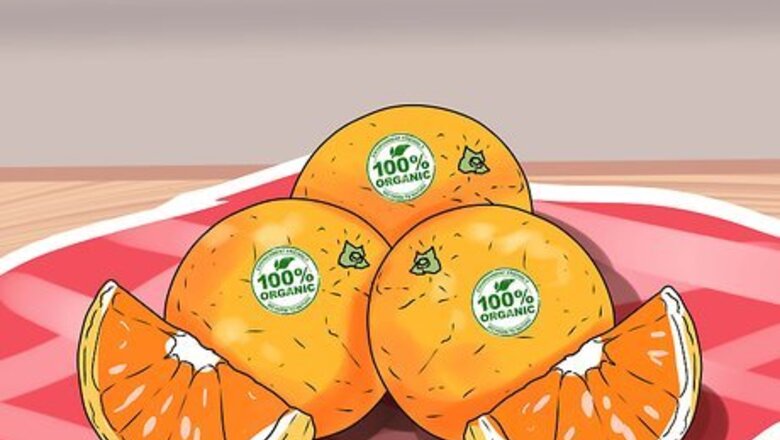
views
Shopping for Food
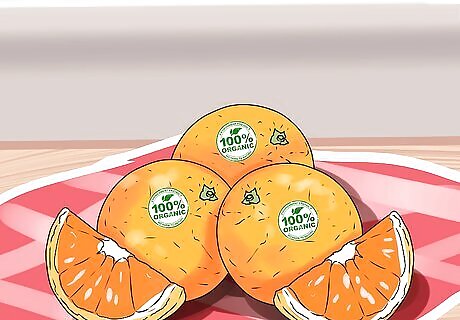
Buy food labeled 100% organic. The U.S. and Canadian governments do not allow manufacturers to label something 100% organic if that food has been genetically modified or been fed genetically modified feed. You may find that organic food is more expensive and different in appearance from conventional products. Trusted Organic Certification institutions include the United States Department of Agriculture(USDA), Quality Assurance International (QAI), Oregon Tilth, and California Certified Organic Farmers(CCOF). Look for their mark of approval on the label of the product. Also, just because something says "organic," it does not mean that it doesn't contain GMOs. In fact, it can still contain up to 30% GMOs, so be sure the label says 100% organic. Eggs labeled "free-range," "natural," or "cage-free" are not necessarily GMO free; look for eggs that are 100% organic.
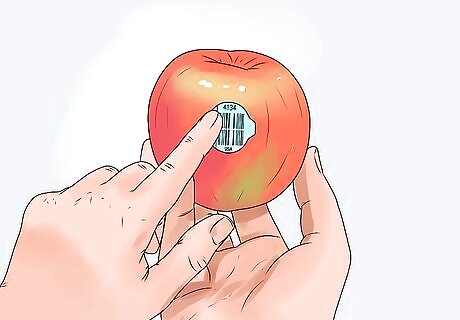
Recognize fruit and vegetable label numbers. Price lookup (PLU) codes can be found on the stickers that are on your produce. These codes can be used to identify foods have been genetically engineered or modified. If it is a 4-digit number, the food is conventionally produced. This food may or may not be genetically modified. If it is a 5-digit number beginning with an 8, it is GM. However, do not trust that GE foods will have a PLU identifying it as such, because PLU labeling is optional. If it is a 5-digit number beginning with a 9, it is organic and is not genetically modified
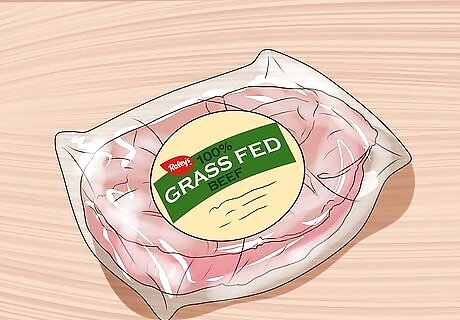
Buy 100% grass-fed meat. Most cattle in the U.S. are grass-fed but spend the last portion of their lives in feedlots in which they may be given GM corn, the purpose of which is to increase intramuscular fat and marbling. If you're looking to stay away from GMOs, make sure the cattle were 100% grass-fed or pasture-fed (sometimes referred to as grass-finished or pasture-finished). Some meats like pork and chicken cannot be 100% grass fed. In those instances, look for meat that is labeled 100% certified organic. You should also buy wild caught fish instead of farm raised fish. Farm raised fish are fed with genetically modified grains.
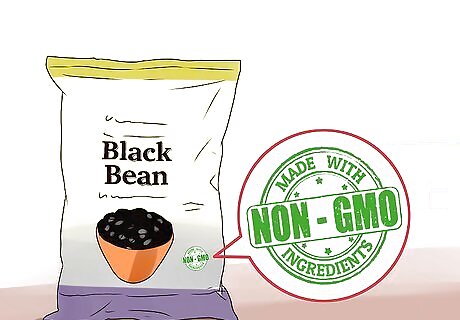
Seek products that are specifically labeled as non-GMO or GMO-free. It was once rare to find products labeled as such, but thanks to organizations such as the Non-GMO Project, they are becoming more common. You can also research websites that list companies and foods that do not use genetically modified foods, but be aware that some information is often incomplete, and conflicting interests may not be declared.
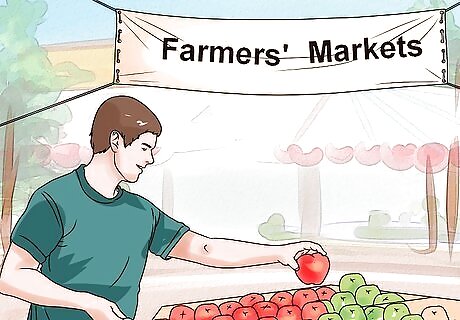
Shop locally. Although more than half of all GM foods are produced in the U.S., most of it comes from large industrial farms. By shopping at farmers' markets, signing up for a subscription from a local Community Supported Agriculture (CSA) farm, or patronizing a local co-op, you may be able to avoid GM products and possibly save money at the same time. Shopping locally may also give you the opportunity to speak to the farmer and find out how he or she feels about GMOs and whether or not they use them in their own operation. Buying local food does not guarantee that you will be avoiding GMOs. Many local farmers use genetically modified seeds.

Buy whole foods. Favor foods that you can cook and prepare yourself, rather than foods that are processed or prepared (e.g., anything that comes in a box or a bag, including fast food). What you lose in convenience, you may recover in money saved and satisfaction gained, as well as increased peace of mind. Try cooking a meal from scratch once or twice a week; you may enjoy it and decide to do it more often.

Grow your own food. If you grow your own food, you buy seeds that have not been genetically modified. This way, you know exactly what was grown and what went into growing it. Many websites sell non-GMO seeds.You can visit Seed Savers or Seeds Nowto find non-GMO seeds.
Identifying Foods Most Likely to Contain GMOs

Become familiar with high-risk crops. These are the products that are most likely to be genetically modified. Crops that are genetically modified include soy, corn, canola, sugar beets, cotton, Hawaiian papaya, zucchini and yellow summer squash, and alfalfa. Soy is not limited to actual soybeans. See How to Live With a Soy Allergy for more information on avoiding soy products. Make sure that your soy milk, edamame, and tofu have a 100% certified organic label. Corn includes corn flour, meal, oil, starch, gluten, and syrup. Canola oil is also known as Rapeseed oil. This ingredient can be found in a lot of processed foods. If you usually use Canola oil for cooking, try using olive oil instead. Sugar beets are found in any sugar that is not 100% cane sugar. Make sure you read the label. Cottonseed oil is a common ingredient in vegetable oil. shortening, and margarine. Many dairy products contain GMOs. Some farmers inject their cows with a genetically modified hormones rBGH/rBST and/or are fed genetically modified grains. You should look for dairy products that say rBGH or rBST free. Hawaiian papayas are genetically modified. You should buy papayas grown in other regions like the Caribbean. We usually do not directly ingest alfalfa. Alfalfa is grown to feed dairy cows and other animals. Both organic alfalfa and genetically engineered alfalfa are grown. You can avoid genetically engineered alfalfa by eating grass fed meat and dairy products that are 100% certified organic.
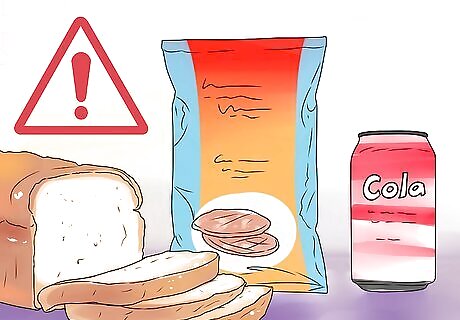
Be aware of ingredients derived from GMO crops. Not only are the actual crops genetically modified, but an ingredient that is derived from the crop is genetically modified as well. If you are buying processed foods, you should read the food label and avoid any of these ingredients: amino acids (synthetic form, not naturally occurring in protein), aspartame, ascorbic acid (synthetic vitamin c), sodium ascorbate, citric acid, sodium citrate, ethanol, natural and artificial flavorings,high fructose corn syrup, hydrolyzed vegetable protein, lactic acid, maltodextrins, molasses, monosodium glutamate, sucrose, textured vegetable protein, xantham gum, vitamins, and yeast products. About 75% of processed foods at the grocery store contain these ingredients. This includes foods like soda, cookies, bread, and chips. You can avoid these derivatives by cooking your food from scratch and carefully buying your food.
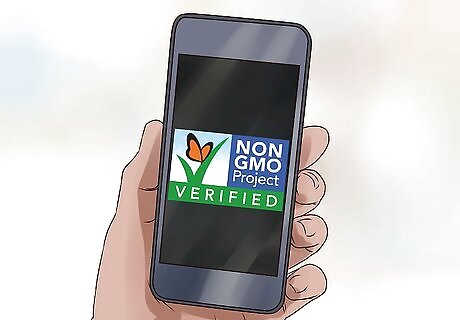
Use a shopping guide. There is no way for you to know every food that contains GMOs. If you are unsure, you should consult a GMO food guide. The Center for Food Safety has created an iPhone and Android app that can help you avoid GMOs when you are shopping. You can also download or use their online guide.

Be careful when you eat at a restaurant. If you eat out, you should ask the manager or your waitress if they use organic ingredients or if they use GMO ingredients. If they do not use organic foods, you should avoid tofu, edamame, corn tortillas, corn chips, and any other products that contain corn or soy. Most of the items containing sugar will contain GMO derivatives. You should also ask what type of oil is used for cooking. If they say vegetable oil, margarine, cottonseed oil, or corn oil, ask if they can cook your food with olive oil instead.


















Comments
0 comment